On Writing Dialogue: How to Write Better & Believable Lines
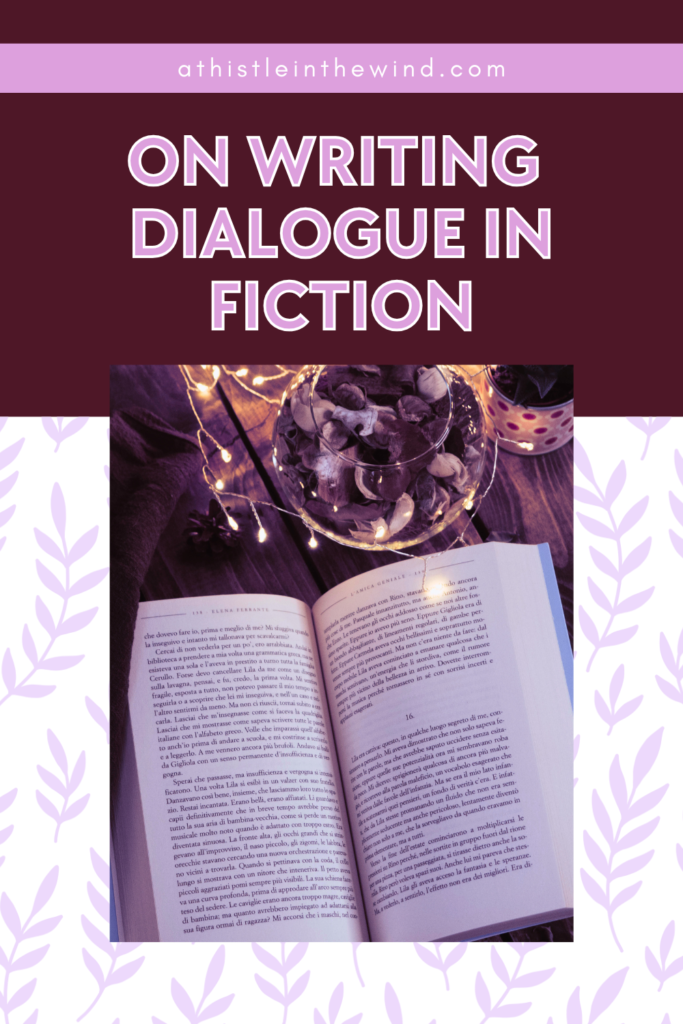
After dropping my marathon of a guide on world building, I think the next best topic to cover would be on writing dialogue. Specifically, writing better dialogue. One of the biggest criticisms I got on my manuscript’s first round of edits was on this. While my world building was strong, characters pretty good, I found myself often telling, rather than showing through my dialogues.
And if you’re anyone with a tiny bit of interest in writing, you know how important dialogues can be. They can reveal critical information, help us understand the psychology or motivation of a character, or through subtext, also give us a glimpse in the potential trajectory of a novel’s plot.
Naturally, as you can imagine, writing dialogues requires focus, deliberation and a bit of flair to distinguish characters from each other. And that’s exactly what I’m doing in this blog. So, without wasting any more time, let’s dive in!
The Power of Believable Banter
Great dialogue depends on its believability. Depending on the world, the setting and tone of your book, you need to ensure that your dialogues match these things. If your dialogues break from the overall world you’ve created, readers won’t believe that it’s an actual thing that’s said and will be able to see through it.
As I write this, I’m immediately taken back to this moment in Air Awakens, a book I finished a while back. The world established was this fantasy place with sorcerers who could weld the power of certain elements (more on that in my March reading list). There were kings, princes, castles and all that. However, there was a particular adult joke that was added in the middle of a scene between two characters that broke the illusion for me. Immediately.
Now, I understand the importance of shock value. But, the point of a good book is to show readers the story. The best books with the best plot twist aren’t the ones where someone drops an unexpected F-bomb or adult joke. Sure, certain characters can be crass to get a point across. But adding out-of-place random jokes really isn’t how to do it. Especially since it was so uncharacteristic of the speaker. I guess the author was trying to be edgy, and that’s fine; you can be edgy. But if you have to break from the tone and personality of your characters to do that; you might want to reconsider some things.
Think of Katniss and Peeta in The Hunger Games—their exchanges are layered with survival instincts, vulnerability, and underlying attraction. Jane Austen’s novels, especially Pride and Prejudice, masterfully balance subtext and social nuances—Elizabeth and Darcy’s verbal exchanges are legendary.
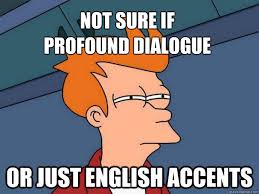
Understanding the Core Functions of Dialogue
1. Dialogue as Action
As a writer, when you’re writing dialogue, it’s important to remember that its main purpose is to push your story forward. This is where the concept of attack and defence in dialogue comes in. Conversations are often verbal duels, whether they’re playful or deadly serious.
Even in romance, dialogue-driven conflict is key. In The Notebook, Noah and Allie’s fights are emotionally charged, each trying to break through to the other. Words aren’t just spoken—they wound, heal, or provoke.
2. Dialogue as Character Revelation
What a character says—and what they don’t say—tells us who they are. As I’ve mentioned before, dialogue reveals motivations, upbringing, education, and personal history, making characters feel distinct.
Tyrion Lannister from A Song of Ice and Fire is a perfect example. His witty, self-deprecating dialogue masks his vulnerability, while his sharp insults act as armor. Compare that to Mr. Darcy in Pride and Prejudice—his stiff, overly formal way of speaking initially makes him seem cold. But as the novel progresses, his words become softer and more honest, revealing his true nature.
Then there’s Avatar: The Last Airbender. Zuko’s early dialogue is filled with anger and entitlement, reflecting his desperate need to prove himself. As he grows, his speech softens, showing internal conflict and eventual self-awareness. The way a character speaks—whether through long, flowery monologues or short, clipped sentences—tells us more than their words alone.
3. Dialogue as World Building
The way characters speak can subtly establish societal norms, historical context, and even political structures. In The Hobbit, the way elves, dwarves, and humans speak varies greatly—elves are poetic and measured, while dwarves are blunt and pragmatic. This immediately tells us something about their cultures.
In A Song of Ice and Fire, noble characters speak in refined, formal tones, while mercenaries and common folk use rougher, more colorful language. The words characters use—and don’t use—define the world they inhabit.
Avatar: The Last Airbender masterfully uses dialogue to build its setting. The Fire Nation’s rhetoric is steeped in conquest and superiority, while the Earth Kingdom’s speech patterns reflect resilience. Even casual jokes, like Sokka’s constant food-related complaints, make the world feel lived-in and real.
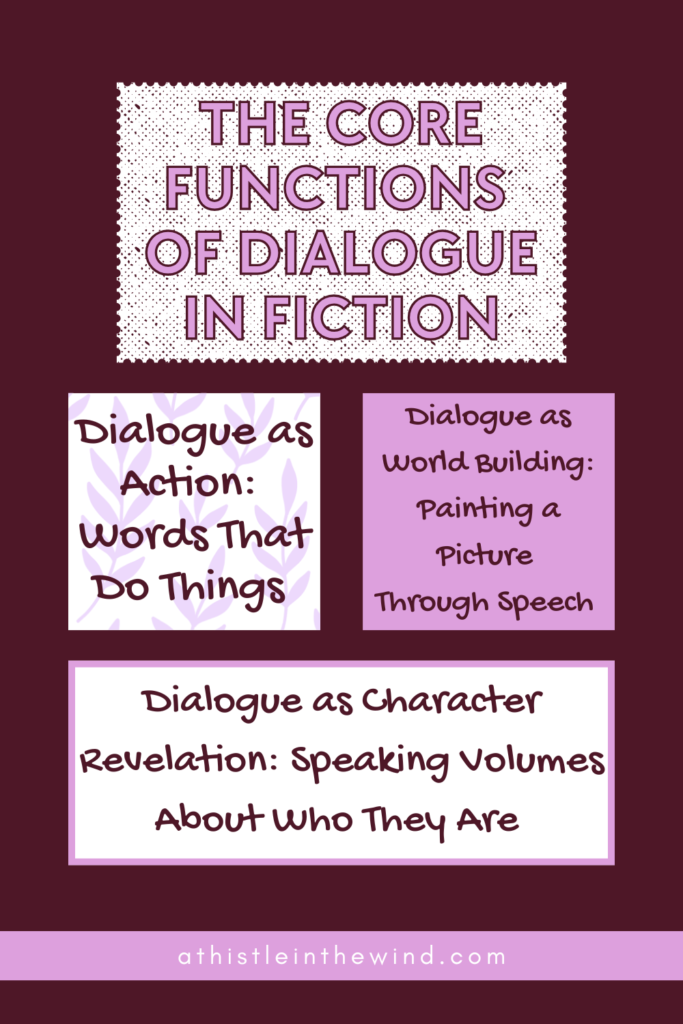
Key Techniques for Crafting Effective Dialogue
Now that you understand the core function of dialogue, let’s take a look at some techniques you use to write better dialogue.
1. The Importance of Subtext
One of the most powerful tools in dialogue is subtext—the meaning that lies beneath the words. A character might say one thing but mean something entirely different. This is where the Iceberg Theory (coined by Hemingway) comes into play: only a fraction of the meaning is visible, while the deeper emotions and intentions remain submerged.
In Pride and Prejudice, Elizabeth Bennet and Mr. Darcy’s early conversations are thick with subtext. Their sharp exchanges aren’t just about what’s being said—they reflect pride, prejudice, and hidden attraction. Neither openly confesses their feelings until much later, keeping the reader engaged.
This kind of verbal sparring forces the audience to read between the lines, making dialogue far more compelling.
2. Building Strong Scenes for Stronger Dialogue
Even the best-written dialogue will fall flat if it doesn’t serve the scene. A strong conversation isn’t just a back-and-forth—it’s part of a structured moment with a clear goal.
Before writing dialogue, ask:
- What’s the purpose of this scene?
- What change needs to happen through this conversation?
- How much dialogue is actually necessary?
Effective scenes shift from positive to negative (or vice versa). For example, in Avatar: The Last Airbender, Zuko’s heated argument with Uncle Iroh about honor starts with Iroh offering wisdom and ends with Zuko storming off, reinforcing his inner turmoil. The shift in emotional weight makes the scene more impactful.
Power dynamics also shape conversations. Who has control? Who is trying to gain it? A dialogue between a detective and a suspect will have a completely different rhythm than one between two close friends.
3. Finding the Sweet Spot
Real-life conversations are filled with “um,” “uh,” and small talk—but fictional dialogue should be streamlined. The goal is naturalistic, not real.
Good dialogue should:
- Avoid unnecessary filler
- Keep exchanges focused on the story’s needs
- Maintain a rhythm that feels authentic without being tedious
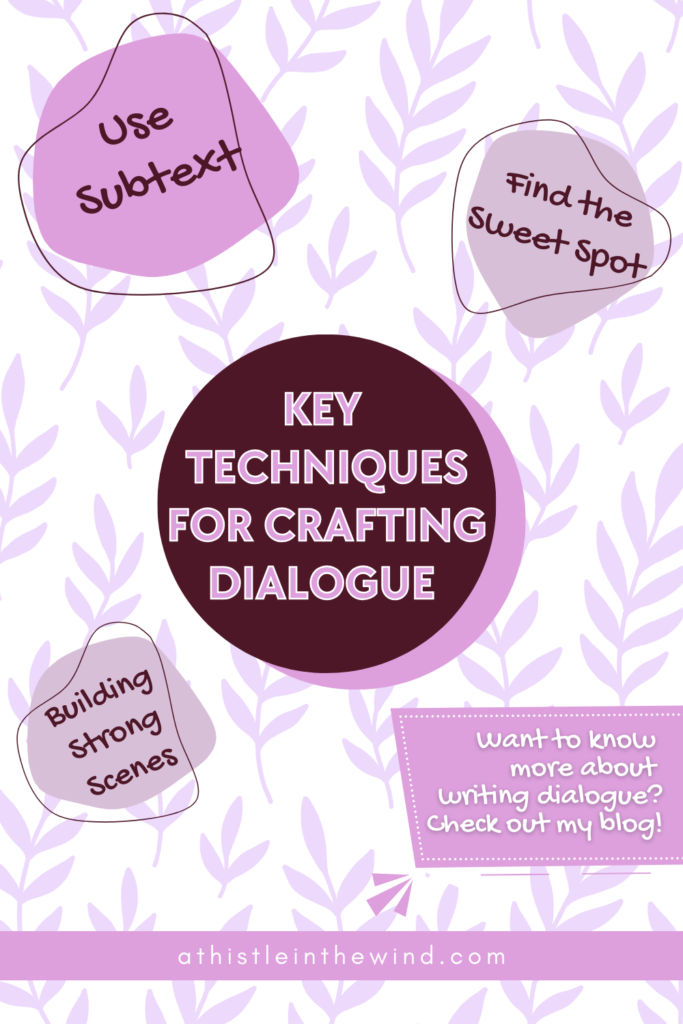
How to Add Depth and Nuance to Your Dialogue
There are several steps you can take to add more depth and nuance to your dialogues. Here’s how you can do it.
1. Master Dialogue Tags and Action Beats
Many new writers fall into the trap of bugisms (overly descriptive dialogue tags like “growled,” “exclaimed,” or “shrieked”). I’ll admit that this is something I’ve done a lot. While these can be effective in moderation, they often tell the reader how a character feels rather than showing through context. This is where action beats shine. Small movements, gestures, or body language woven into dialogue can subtly reinforce meaning.
Overloading dialogue with constant action beats can make conversations feel sluggish. Sometimes, letting characters just talk is the best option, especially in fast-paced exchanges. Of course, certain dialogue tags—like whispered, gasped, murmured—can be useful when they efficiently indicate tone. But the goal should always be clarity first.
2. Develop Distinct Character Voices
Every character has a different worldview, background, and way of processing information. So, as a writer, try to get this across when you’re writing dialogue. Your characters should be able to discuss the same topic with a different approach—even if they’re in agreement. In Pride and Prejudice, Mr. Collins speaks in overly long, pompous sentences, whereas Elizabeth Bennet’s speech is sharp and witty.
Key techniques for distinct voices:
- Vary sentence structure: short, clipped dialogue vs. long, winding speech.
- Use different vocabulary: a scholar won’t talk like a street thief.
- Consider formality levels: does a character say “yes” or “yeah?”
- Think about what they focus on: a pessimist and an optimist won’t describe the same event the same way.
That said, not every character needs to have an extreme contrast. Some variation is natural—people in the same social circles may have overlapping speech patterns. The key is ensuring that, over time, each character feels like an individual.
3. Create the Illusion of Realistic Conversation
When writing dialogue, you don’t have to recreate an exact replica of real speech—it just needs to feel real. In real life, conversations often go off-track, overlap, or contain awkward pauses. While you don’t want to fully mimic this, incorporating a touch of realism can make dialogue more dynamic. Here’s how:
- Let characters misinterpret each other or talk past each other.
- Use sentence fragments and interruptions (sparingly) for natural rhythm.
- Embrace subtle non-sequiturs—people don’t always respond in direct, linear ways.
4. Knowing When to Show and When to Tell
Not every conversation needs to be fully written out. Sometimes, summarising dialogue can maintain pacing and keep the reader focused on what truly matters. For instance, instead of detailing a long back-and-forth about where the characters will meet, you can write: “They agreed to meet at the docks at dawn.”
This technique is useful for:
- Skipping mundane small talk: we don’t need full greetings and goodbyes.
- Covering logistical conversations quickly: how characters split up, etc.
- Avoiding redundancy: if information is already known, don’t rehash it.
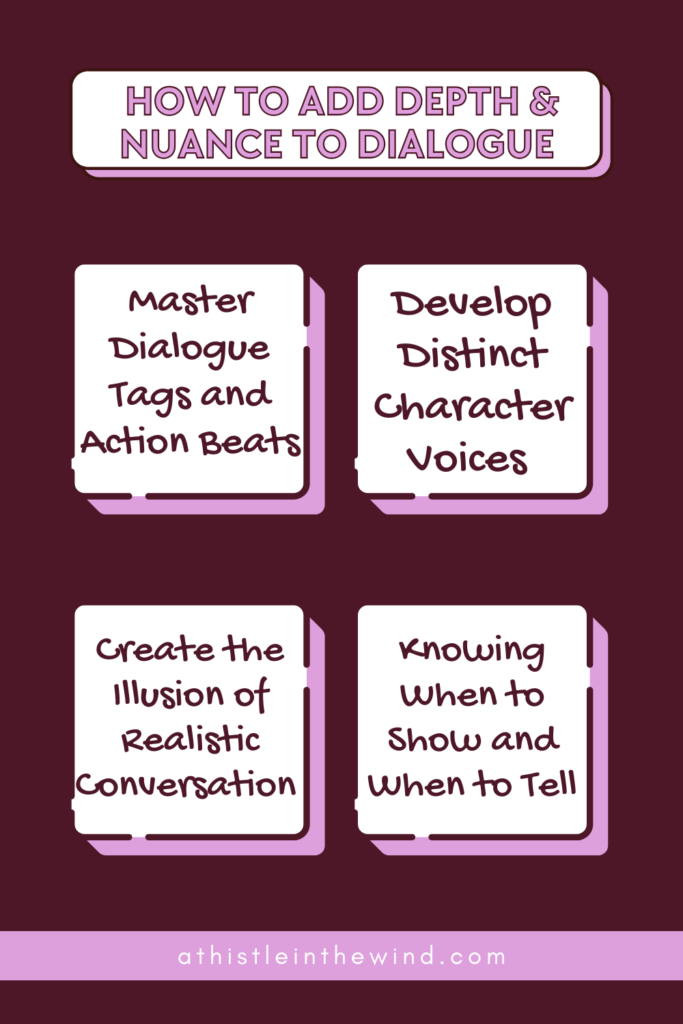
Tips to Polish Your Dialogue
1. Ditch Empty Talk
Readers don’t need to see characters do or say everything unless it contributes to the mood or subtext. By cutting filler, your dialogue remains engaging and purposeful.
2. Treat Dialogue Like a Battle
Think of every interaction as an exchange of attacks and defenses. Who is trying to gain the upper hand? Who is withholding something?
3. Incorporate Actions and Reactions
Avoid the “talking heads” effect—where dialogue exists in a void. Ground your characters with movement and reactions. Small physical cues add emotional weight and make scenes feel more dynamic.
4. Listen to Your Words
Dialogue should sound natural when read aloud. If a line feels clunky or unnatural, revise it until it flows smoothly. Well-crafted dialogue should feel spoken, not written.
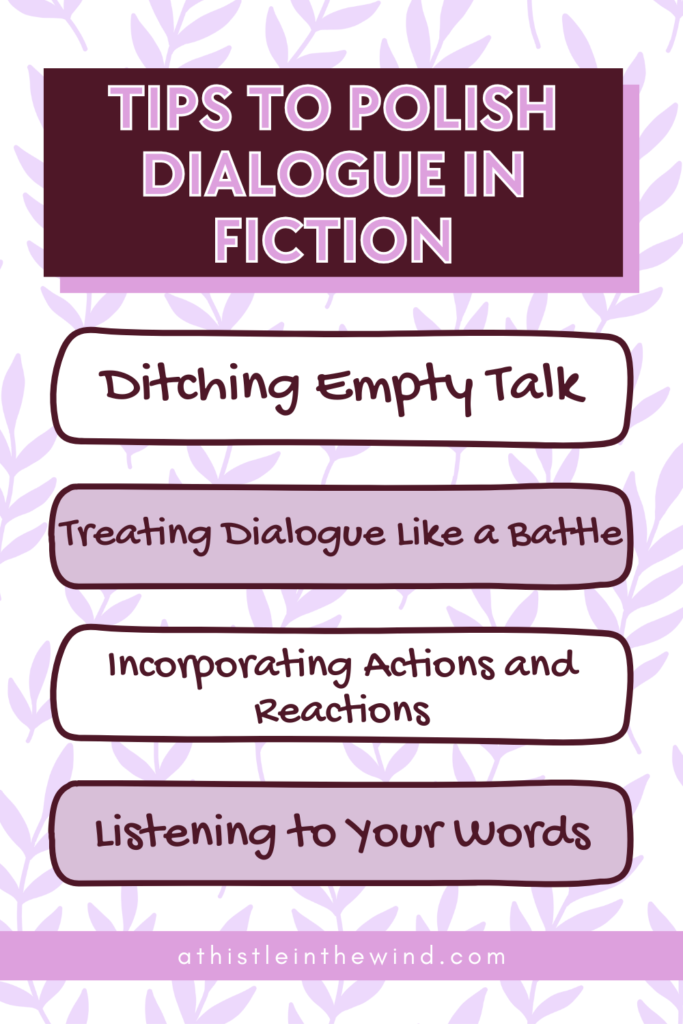
Give Your Characters a Voice That Sings
In the end, don’t forget to have fun with your characters! Writing dialogue offers a way for you to really show what your characters are all about. Seriously, you could have the most well-written character description; the most well-thought out plot and more, but if your character sounds bland? Well, that can really let down your story.
Characters drive stories as much as the plot and your writing. So, remember: dialogues can be tricky but with this guide, you can easily write better dialogues.
If you’re interested in more blogs about writing books, check out these blogs:


